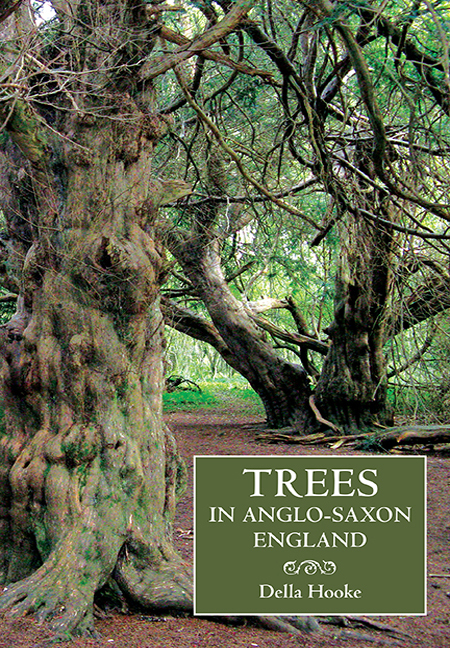Book contents
- Frontmatter
- Contents
- List of Illustrations and Tables
- Preface and Acknowledgements
- List of Abbreviations
- PART I Tree Symbolism
- PART II Trees and Woodland in the Anglo-Saxon Landscape
- PART III Individual Tree Species in Anglo-Saxon England
- Chapter 8 Trees of Wood-Pasture and ‘Ancient Countryside’
- Chapter 9 Trees of Wet Places in Early Medieval Records: Alder and Willow
- Chapter 10 Trees of Open or Planned Countryside
- Chapter 11 Other Trees Noted in Charters and Early Place-Names
- Chapter 12 Trees not Readily Apparent in the Early Medieval Written Record
- Epilogue
- Bibliography
- Index
- Anglo-Saxon Studies
Chapter 10 - Trees of Open or Planned Countryside
from PART III - Individual Tree Species in Anglo-Saxon England
Published online by Cambridge University Press: 09 May 2017
- Frontmatter
- Contents
- List of Illustrations and Tables
- Preface and Acknowledgements
- List of Abbreviations
- PART I Tree Symbolism
- PART II Trees and Woodland in the Anglo-Saxon Landscape
- PART III Individual Tree Species in Anglo-Saxon England
- Chapter 8 Trees of Wood-Pasture and ‘Ancient Countryside’
- Chapter 9 Trees of Wet Places in Early Medieval Records: Alder and Willow
- Chapter 10 Trees of Open or Planned Countryside
- Chapter 11 Other Trees Noted in Charters and Early Place-Names
- Chapter 12 Trees not Readily Apparent in the Early Medieval Written Record
- Epilogue
- Bibliography
- Index
- Anglo-Saxon Studies
Summary
While most trees recorded in pre-Conquest contexts were naturally found where ancient or relict woodland was plentiful, two species stand out as being referred to rather more often, at least in charters, in farmed landscapes: the thorn and the elder (Fig. 17). Species of thorns were common everywhere but both the blackthorn (the sloe) and the whitethorn (the hawthorn) readily colonise abandoned arable land, pasture fields and pockets of waste ground. In addition, both these species have been planted as hedgerow trees as they form a quick-growing and effective barrier. The elder, too, grows readily wherever there is a high nitrogen content in the soil, flourishing, therefore, near abandoned dwellings, animal setts and country churchyards. Birds carry the seeds in their droppings and the tree colonises suitable land very quickly, growing rapidly and vigorously.
THE ELDER
The elder, Sambucus nigra (OE ellen), is the tree species that is especially noted in the early Christian edicts against tree-worship – the tree of witches. It is the tree singled out by Wulfstan in the Canons of Edgar, c.1005–8, noted in Chapter 2, as a place for the carrying out of ‘devil's craft’, although what practices this involved remain unspecified. Paterson notes the anthropomorphic nature of this tree, regarded as an abode of the ‘Elder Mother’, called Elle or Hyldemoer in Scandinavian and Danish myth; it was she who worked strong earth magic and avenged all who harmed her host trees. Because of this, the tree was, in popular folklore, traditionally treated with awesome respect. Witches were thought to have been able to turn themselves into elder trees, and one such ‘elder witch’ was involved in the legend of the Oxfordshire Rollright Stones, turning the king and his men to stone. People are said to have danced here in the past on Midsummer's Eve, with elder garlands in their hair, but Christian reaction to these activities led to other customs, which involved cutting the elder in order to ‘bleed’ the witch. The damaged witch returning to human form might be recognised by the marks on her person of the damage caused.
- Type
- Chapter
- Information
- Trees in Anglo-Saxon EnglandLiterature, Lore and Landscape, pp. 232 - 244Publisher: Boydell & BrewerPrint publication year: 2011

